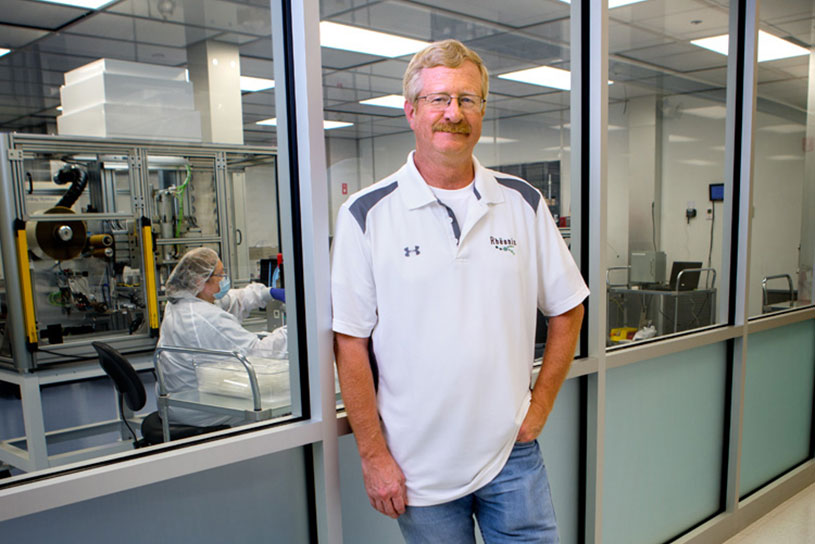Profile in Leadership: Greg Galvin, MS ’82, PhD ’84, MBA ’93

Creating Successful High-Tech Startups in Ithaca

With a doctorate in material science from Cornell, Greg Galvin understood the intricacies of physics and electrical engineering but didn’t want to spend his days in a lab. With a Cornell MBA , he also knew the principles of accounting and marketing but didn’t want to leave the science behind.
So in 1993, he combined his complementary strengthsand launched his first startup, Kionix, licensing agroundbreaking technology developed at Cornell. By2009, Galvin had sold the company twice — for a totalof $533.5 million — and created 250 technical andmanufacturing jobs in Ithaca. He had also started hissecond company, Rheonix, which produces moleculardiagnostic testing systems.
A soft-spoken and self-effacing man, Galvin builta portfolio of successful high-tech startups in Ithacawith a strong dose of perseverance, grueling days, anddedication to his employees. Yet his unusual backgroundin both science and business allowed him to become thatrare type of entrepreneur who can not only envision thetechnology that will thrive in the marketplace but whocan also develop the organization needed to produce it.”Greg is probably the most talented person I’ve everknown or worked for,” says Jim Kirkwood, the formerchief operating officer of Kionix, now CEO of EndicottMachine and Tool in Endicott, N.Y. “He understandsall the different aspects of owning your own business.He understands the technology as well as the engineering.He understands the sales and marketing so he cango into a customer meeting and understand all theplayers at the table. If he’s in a room with engineers, hecan speak the technical talk. I always say, ‘Greg is two orthree steps ahead of anyone else sitting in the room.'”
Galvin’s first passion for science was a childhooddream to become a doctor. But after discovering hedespised organic chemistry, he ended up graduatingfrom the California Institute of Technology with adegree in electrical engineering and followed a professorto Cornell to become one of his first graduate students. Galvin then spent four years conducting research on the solidificationdynamics of silicon under ultra-rapid heating.
By the time he earned his doctorate, Galvin had become moreinterested in the business side of science, but the positions he wasoffered didn’t match his diverse skill set. “The companies had thisidea that if you’re a PhD, you go in the lab and do science,” herecalls. “I found it very difficult to get anyone to consider me formore of a product management position or something that mergedthe business side of the organization along with the science.”
Instead, Galvin took the less typical path for a newly mintedPhD: He became deputy director at the Cornell NanofabricationFacility, where he made connections with the scientists whoseresearch would eventually become the basis for Kionix. Developedby Professor Noel MacDonald, the technology, known as MEMS(micro-electro-mechanical systems), builds mechanical systems on amicroscopic scale.
After taking a position with Cornell’s corporate researchrelations, Galvin was asked to identify companies that wanted tolicense the MEMS technology. Unable to find any, he decided todevelop the technology himself and invited an electrical engineeringdoctoral student he had met on campus, Tim Davis, PhD ’93, tojoin the startup. He called it Kionix, taken from the Greek wordkíön, meaning “pillar,” as he viewed the microstructures comprisingthe MEMS device as tiny silicon pillars.
“For Kionix, Greg jokes that we did everything wrong,” says Davis,the company’s chief technology officer. “We started a companythat needed a lot of money to develop the technology and createboth a product and a market. But even though we did everythingwrong, he made it work.”
Galvin made it work primarily because of his doggedness seekingventure capital for a startup in Ithaca, which has traditionally beenoverlooked by the major investment firms on either coast. UpstateNew York, Galvin notes, ranked third from the bottom in theamount of venture capital it received among all regions across thecountry in the second quarter of 2015, according to a report byPricewaterhouseCoopers. While upstate generated $22.2 million infinancing, the number one region — Silicon Valley — raised $9.1billion, followed by the New York metro area, with $2.3 billion.”There’s a ton of federal research funding coming into this region,but we rank nearly last for venture capital,” Galvin says. “That tome epitomizes the problem that we face in trying to generate thisentrepreneurial ecosystem and entrepreneurial activity in CentralNew York.”
Despite those odds, Galvin was able to raise $13 million tolaunch Kionix by securing small amounts of money from a largenumber of investors, including family members, friends, and Cornell associates. One of those investors, Cayuga Venture Fund, basedin Ithaca, not only provided financing for Kionix but also fundedGalvin’s succeeding business ventures.
“We felt that their technology was advantaged and was goingto create a marketplace for them, although they were competingagainst huge companies,” says Phil Proujansky, a managing partnerwith Cayuga Venture Fund. “It took awhile to get there — it’salways hard for a startup to compete against huge companies — butthey got traction in the marketplace.”
Kionix’s first product was a set of micromirrors — each less thana millimeter on its side — that could switch fiber-optic signals. Thisniche product was in demand during the telecommunications boomin the late 1990s, as companies were exploring how to transmit andredirect fiber-optic signals in the Internet backbone.
As its products gained visibility in the market, Kionix attractedthe attention of Calient Networks, a California optical circuit switching company that bought the startup for $300 million in2000. But in a move Davis, his co-founder, calls “brilliant,” Galvinspun off a separate technology that focused on inertial sensors,creating the framework for a second incarnation of Kionix.
“The brilliance in it was structuring the deal so that he could sellonly part of the company and retain part of the intellectual propertyto develop in new fields,” Davis says. “By being able to manipulatethat situation so that you could retain enough and yet get enoughmoney in the sale to fund the new activity was, I think, the keyturning point not only for Kionix, but for Greg.”
The next generation of products of what came to be known asthe “new Kionix” were devices that could be installed in laptopcomputers to detect if they were falling — if they sensed free fall,the devices would lock the heads on the disk drives before impact,preventing any damage to stored data. Kionix reached a milestonewith the product when Apple purchased it to use in its MacBook,catapulting the startup to the top of the consumer electronicsmarket.
Kionix developed two more highly profitable applications forits inertial sensors: enabling cell phones to switch from portraitto landscape mode and making possible motion-based computergaming systems. When the technology was adopted by such majormanufacturers as Samsung, Microsoft, and Nintendo, employmentat Kionix grew to 250 people.
“The company ultimately went to a 24/7 operation,” says Galvin,who is known for wearing jeans, a polo shirt, and sneakers to work.”We had four shifts staffing the production facilities as well as agrowing sales force and technical support worldwide.”
As Kionix became a leading supplier of inertial sensors, anotherbuyer for the technology emerged: Rohm Co., Ltd., a Japanesesemiconductor company, which bought the startup for $233.5million in 2009. A year before the sale, however, Galvin had alreadyspun off a different product line developed at Kionix — a platform for the molecular diagnostics industry — that became the basis forhis second company, Rheonix — taken from the word rheology, thestudy of fluid flows.
With 62 employees, Rheonix is now conducting clinical trialson its first product, a completely automated molecular diagnosticsystem that will identify sexually transmitted infections. Futureiterations of the platform will be designed to detect respiratoryviruses and cancer.
Delving into medical diagnostics is another example of Galvin’swinning strategy. While devices that detect infectious diseases arealready used by hospitals, Galvin believes Rheonix can improve thetechnology by fully automating the process, guaranteeing test resultsin hours rather than days, and reducing the cost of the test whiledelivering more clinical information.
“Greg is a very strategic thinker,” says Kenny Salky, vice presidentfor sales for Rheonix, who formerly worked for Kionix. “Heunderstands the market and understands where we should be andhow to get there, and he doesn’t do it in a very complicated way.”
Galvin’s latest venture is Incodema3D, a company he foundedwith three partners in Ithaca last January. The startup is applying3D printing to manufacture parts for the aerospace industry thatweigh less and can have much more complex geometric shapes thanthose fabricated through traditional machining.
3D printing is yet another disruptive technology Galvin is guidinginto what he predicts will become a rapidly expanding industry.”I don’t know that there’s something magic about what I do versussomebody else,” he says. “I think I’m pretty good at organizing andmanaging people, understanding the technology, understanding themarketplace, and setting the vision for where it is we should be goingto be successful. But at the end of the day, it’s about getting theright set of people together who have the right talents and abilities toactually execute it.”
